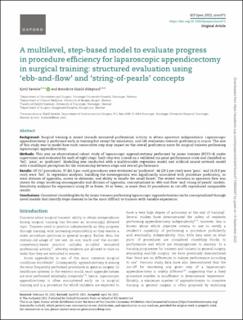A multilevel, step-based model to evaluate progress in procedure efficiency for laparoscopic appendicectomy in surgical training: structured evaluation using 'ebb-and-flow' and 'string-of-pearls' concepts
Journal article, Peer reviewed
Published version

Åpne
Permanent lenke
https://hdl.handle.net/11250/3018365Utgivelsesdato
2022Metadata
Vis full innførselSamlinger
- Department of Clinical Medicine [2066]
- Registrations from Cristin [9791]
Sammendrag
Background
Surgical training is aimed towards entrusted professional activity to obtain operative independence. Laparoscopic appendicectomy is performed early in training but except for simulators, real-life evaluation towards proficiency is scarce. The aim of this study was to model how each consecutive step may impact on the overall proficiency score for surgical trainees performing laparoscopic appendicectomy.
Methods
This was an observational cohort study of laparoscopic appendicectomy performed by junior trainees (PGY1–4) under supervision and evaluated for each of eight steps. Each step was scored on a validated six-point performance scale and classified as ‘fail’, ‘pass’, or ‘proficient’. Modelling was conducted with a multivariable regression model and artificial neural network model with a multilayer perceptron for the relationship between steps and overall performance.
Results
Of 157 procedures, 97 (61.8 per cent) procedures were evaluated as ‘proficient’, 46 (29.3 per cent) were ‘pass’, and 14 (8.9 per cent) were ‘fail’. In regression analyses, handling the mesoappendix was significantly associated with procedure proficiency, as were division of appendix, access to abdomen, and ability to handle the small bowel. The widest variation in operative flow was shown for steps involving mesoappendix and division of appendix, conceptualized in ‘ebb-and-flow’ and ‘string-of-pearls’ models. Sensitivity analyses for experience using 20 or fewer, 30 or fewer, or more than 30 procedures as cut-offs reproduced comparable results.
Conclusions
Consistent stumbling blocks for junior trainees performing laparoscopic appendectomies can be conceptualized through novel models that identify steps deemed to be the most difficult to trainees with variable experience.
